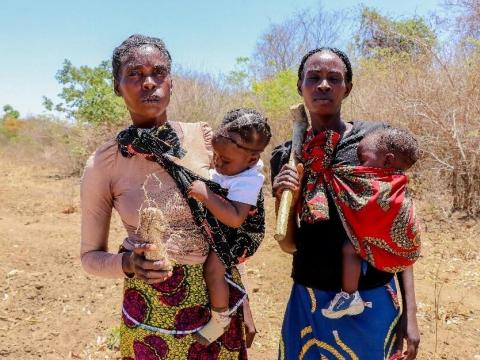
Without climate action, children are denied a healthier tomorrow
Mel paints a bleak picture of how climate change is threatening the health of children and their families around the globe, and highlights how World Vision is responding
7 April, 2022
This year on World Health Day, the World Health Organization asks “Are we able to reimagine a world where clean air, water and food are available to all? Where cities are liveable and people have control over their health and the health of the planet?”
To be honest, I’m not sure I can. Less than two weeks ago both the Arctic and Antarctic hit historic records for heat, with temperatures more than 30°C and 40°C warmer, respectively, than average at this time of year. Extreme weather events and their accompanying natural disasters are increasing at an alarming rate. We are losing precious biodiversity, critical for providing ecosystem services and meeting our nutrient needs, at a time when global hunger and malnutrition are reaching catastrophic proportions. Our planet is sounding every alarm it can, and yet we can’t even agree that climate change is happening.
The erosion of our planetary health is directly jeopardising our own health. The WHO classifies “climate change as the single biggest health threat facing humanity.” Biodiversity loss, freshwater depletion, deforestation, and extreme and unpredictable weather patterns are contributing to death and illness on an increasingly grand scale.
Climate-induced disruptions to the food system, for example, are increasing the risk of hunger and malnutrition. Climate variability, particularly temperature increases, frequent droughts, rainfall variability and unpredictability, and changes in carbon dioxide levels, means that agricultural production is facing an unprecedented challenge to meet the needs of a growing global population. Across the globe, food production is becoming unreliable and the most vulnerable are being left behind in a race to adapt and survive.
There are now 45 million people worldwide who are at extreme risk of famine, a staggering 300% increase during the past six months – largely due to the multiplier effects of conflict, COVID-19 and climate change. This is also reflected in rising levels of malnutrition – with pre-COVID rates of 149.2 million children under five years of age affected by stunting and 45.4 million suffering from wasting. With a child dying from malnutrition-related causes every 11 seconds, it is particularly concerning to hear projections of a 20 per cent increase in hunger and malnutrition by 2050, if we don’t act to improve planetary health now.
The very heart of our global food system’s capacity to deliver affordable, healthy diets for all is at risk.
Elevated carbon dioxide levels are reducing the concentration of important minerals in plants, including calcium, potassium, zinc, and iron. As a result, an estimated 175 million more people could be at risk of zinc deficiency by 2050. With more than 2 billion people suffering from micronutrient deficiencies, losing nutrients in our food is not something we can afford to see.
The erosion of our planetary health is also creating unexpected problems. For instance, it is directly increasing the risk for noncommunicable diseases. Air pollution is causing millions of additional diabetes cases around the world and is increasing the prevalence of cardiovascular disease and associated mortality. The changing environmental conditions are also increasing the transmission of several water-, air-, food-, and vector-borne pathogens. The proliferation of malaria-carrying mosquitoes, one of the leading causes of death for children, is increasing, particularly in previously non-endemic areas. Similarly, changing planetary conditions are driving an increased epidemic potential for viruses like dengue, Zika, and chikungunya.
Behind these climate-sensitive health risks is a story of inequality – where those with less power face the most serious consequences. Women and girls often feel the effects of planetary change most acutely simply because of their gender. For instance, women and girls are often responsible for domestic care responsibilities. As a result, they are forced to travel further for water, fuel, and food. Women also face the most significant physical and mental burden of ensuring the nutritional wellbeing and health of their families. Environmental damage is resulting in an increasing double burden of malnutrition, with both diseases of overnutrition and undernutrition on the rise among children. Since women and girls often already eat last, least and poorer quality food, this deprivation of essential nutrients at critical points in their life can have long-term consequences on their ability to live a healthy and prosperous life.
This relationship between planetary health and human health is complex, but the cost of inaction is serious.
Beyond the increasing numbers of lives lost and disability-adjusted life years (DALYs), the direct cost to health (excluding health-determining sectors such as agriculture) is estimated to be between USD 2 to 4 billion per year by 2030. Clearly, we need to rethink our relationship with our environment, for the health of the planet, our health now, and for future generations.
World Vision is working to do just this:
- Promoting gender equality and women’s empowerment - check out this video from South Sudan - including gender transformative actions for nutrition
- We are looking at ways to shifting diets to more micronutrient rich and sustainable sources, by supporting biofortified crops, planting kitchen gardens, and identifying and promoting locally-available foods in our Positive Deviance Hearth programming
- Strengthening the capacity of health systems to prevent and treat illness and malnutrition, including ensuring environmentally safe water and sanitation facilities.
- Promoting the adoption of nature-based solutions to adapt to climate change, such as through Farmer Managed Natural Regeneration
- Scaling up sustainable and clean energy solutions such as fuel-efficient stoves
- Reducing disaster risk through Disaster Risk Reduction and Climate Change Adaptation
Learn more about World Vision's Nutrition work here and work to address and mitigate the effects of climate change here.
Melani O’Leary is World Vision Canada’s Health Technical Specialist. Follow Melani on Twitter @WorldVisionMel and LinkedIn www.linkedin.com/in/olearymel